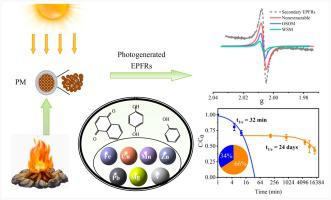Environment International ( IF 10.3 ) Pub Date : 2022-11-29 , DOI: 10.1016/j.envint.2022.107668 Huibin Guo 1 , Yidan Wang 1 , Kaixing Yao 1 , Han Zheng 1 , Xinji Zhang 1 , Rui Li 2 , Ning Wang 3 , Haiyan Fu 1

|
Background
The illumination process may be an important contributor to environmentally persistent free radicals (EPFRs) in atmospheric particles, but the ability of light to generate EPFRs in combustion products remains unclear.
Objective
This paper studies the characteristics and formation mechanism of EPFRs in combustion particles after photoexcitation.
Method
The secondary photochemical processes and the generation and decay capability of EPFRs in size-resolved (<10 µm) biomass combustion particles were analysed by electron paramagnetic resonance (EPR) spectroscopy.
Result
Our results indicated that secondary EPFRs can be generated after illumination and the produced EPFRs have a lifetime of approximately 1 day. The content of secondary EPFRs after light exposure increased by 20 %–30 % compared to that of the original EPFRs. Through the analysis of components of different polarities, it was found that non-extractable substances were the main contributors to secondary EPFRs (75 %), followed by extractable organics. This study showed that metal species and quinones are important precursors for the formation of secondary EPFRs from non-extractable and extractable PM components, respectively. We found that O2 molecules are an important factor for the formation of secondary EPFRs from organic substances without oxygen functional groups.
Conclusions
This study presents information about the effects of light and O2 on the generation of EPFRs, and the unstable nature of secondary EPFRs has important implications for assessing the health risks of atmospheric particles.
中文翻译:

在光照射下从生物质燃烧中收集的颗粒物上被忽视的环境持久性自由基的形成
背景
光照过程可能是大气颗粒中环境持久性自由基 (EPFRs) 的重要贡献者,但光在燃烧产物中产生 EPFRs 的能力仍不清楚。
客观的
本文研究了光激发后燃烧颗粒中EPFRs的特性和形成机制。
方法
通过电子顺磁共振 (EPR) 光谱分析了尺寸分辨 (<10 µm) 生物质燃烧颗粒中 EPFR 的二次光化学过程和生成和衰变能力。
结果
我们的结果表明,二次 EPFRs 可以在光照后产生,并且产生的 EPFRs 的寿命约为 1 天。与原始EPFRs相比,光照后二级EPFRs的含量增加了20%~30%。通过对不同极性组分的分析,发现不可萃取物质是二次 EPFR 的主要贡献者(75%),其次是可萃取有机物。该研究表明,金属物质和醌类分别是不可萃取和可萃取 PM 成分形成次级 EPFR 的重要前体。我们发现O 2分子是从没有氧官能团的有机物质形成二级EPFRs的重要因素。
结论
本研究提供了有关光和 O 2对 EPFR 生成的影响的信息,二次 EPFR 的不稳定性质对评估大气颗粒物的健康风险具有重要意义。











































 京公网安备 11010802027423号
京公网安备 11010802027423号